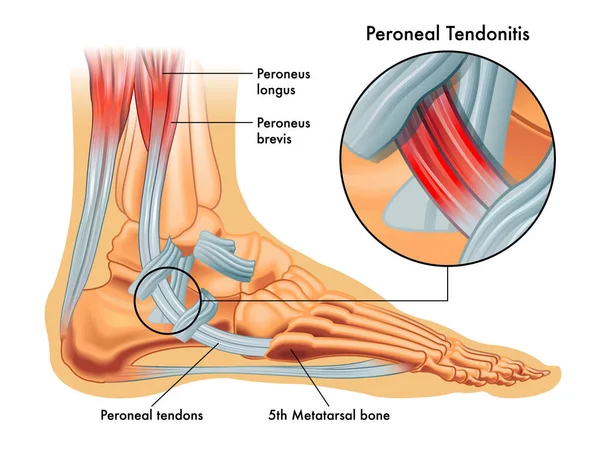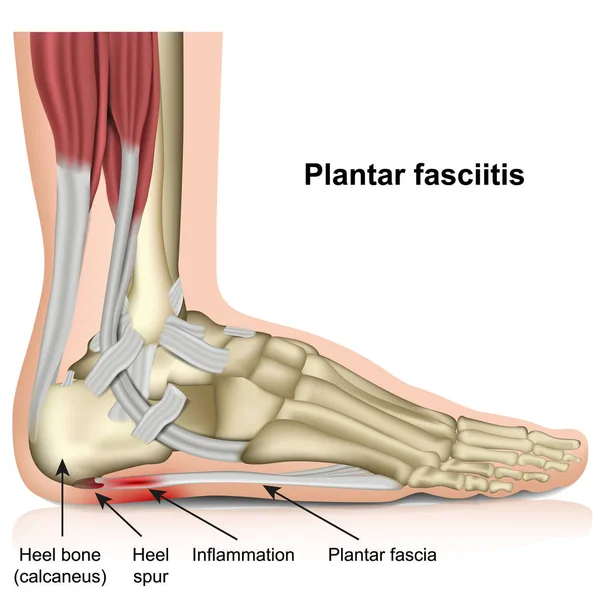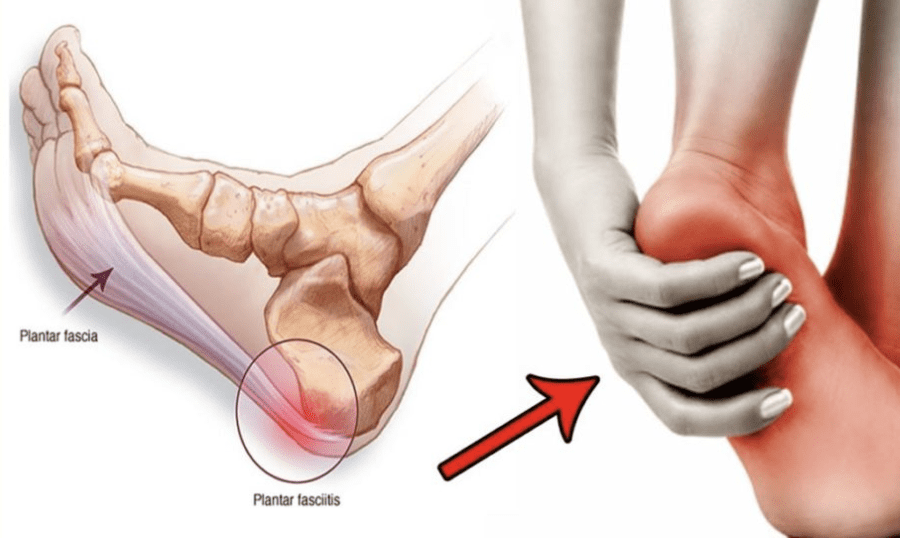If you have been experiencing pain and swelling on the side of your ankle, the culprit may be a peroneal tendon injury. This tendon plays an essential role in stabilizing the foot and ankle, protecting the joint from abnormal or excessive movements that could result in sprains or dislocations.
However, due to repetitive and forceful movements, direct trauma, or improper posture, the peroneal tendon can become damaged or inflamed, thus leading to chronic pain and ankle instability. While acute injuries can be resolved with at-home care, inadequate treatment can turn what initially seemed like a minor problem into a long-lasting, impactful condition. To complicate the picture is the fact that, while peroneal tendon injuries are common, they are often not recognized and, in 40% of cases, are misdiagnosed.
Neuragenex Neurofunctional Pain Management can tackle the inflammation at the root of your pain and help you restore your ankle’s health without medications or surgery. Let’s explore how below.
Peroneal Tendon Anatomy
Tendons are strong bands of connective tissue with the role of connecting muscles to bones. The peroneal tendon, which is composed of two separate tendons, is responsible for connecting structures in the foot, thus providing stability while bearing weight and protecting the ankle from injuries.
The different components of the peroneal tendon attach to the lower part of the fibula (the bone in the lower leg) and continue running side-by-side behind the outer bone of the ankle. These components are:
- The peroneus brevis. The peroneus brevis attaches the fibula to the outer part of the midfoot by the smallest toe.
- The peroneus longus. The peroneus longus runs under the foot and attaches near the inside of the foot’s arch.
- The peroneus tertius. The peroneus tertius plays a role in tilting the sole away from the body’s midline (eversion) and pulling the foot upward (dorsiflexion). A peroneus tertius tear is an extremely rare cause of lateral ankle pain, and this tendon may be absent in nearly 60% of people within certain populations.

Conditions that affect the peroneal tendon (such as tendonitis and dislocations) aren’t uncommon, especially among athletes. It has been seen that 25-77% of patients who experience chronic lateral ankle instability have some type of injury to the peroneal tendon. Of those with peroneal tendon injuries, 10% also have major complications, such as continued symptoms and chronic pain.
Causes And Risk Factors Of Peroneal Tendon Pain
Despite how common peroneal tendon pain is, this condition remains greatly under-recognized and misdiagnosed, which can lead to inadequate treatment and ongoing complications. To diagnose this condition more accurately, it is important to start by pinpointing what its causes and risk factors are.
Firstly, it is important to keep in mind that you are at greater risk of peroneal tendon injuries if you:
- Are aged 40 or over
- Don’t stretch before exercise
- Have a history of tendon injuries
- Have a chronic condition like diabetes
- Have a musculoskeletal condition like osteoarthritis or rheumatoid arthritis
- Are obese or overweight
- Have tight tendons or high foot arches
- Are a smoker
- Wear unsupportive footwear
Below, we’ll look at some of the most common causes of peroneal tendon pain.
Overuse And Repetitive Ankle Motion Due To Sports
Certain activities and sports can place undue pressure on the peroneal tendons, which, over time, can cause the tendons to become inflamed, irritated, or even torn. Those at greater risk of peroneal tendonitis are:
- Runners. Running on sloped streets or uneven terrain can cause the foot to roll outward and increase the friction and tension between the tendon and the bone.
- Marathoners. Marathoners and long-distance runners typically suffer from peroneal tendonitis due to repetitive motion.
- High-impact sports. Sports that involve quick, forceful movements of the foot, as well as jumping and squatting can overstretch and cause micro-tears in the ligament.
If you participate in these sports, consider working with a specialized coach who can help you prevent foot and ankle injuries – which are among the most common injuries among runners and other athletes.
Sudden Trauma
Traumatic injuries can occur due to impact, such as in the case of vehicle collisions. These can lead to fractures and dislocations of the foot, which pulls on the peroneus tendon and leads to pain.
Non-contact injuries are also a common cause of peroneal tendon pain. These can happen due to abnormal ankle movements or landing awkwardly on a twisted foot. Common non-contact injuries are:
- Inversion of the ankle
- Excessive or forceful dorsiflexion (raising your toes toward your shin)
- Ankle sprains
- Recurrent dislocation of the peroneal tendons
Poor Form While Training
If you are an athlete, your form during training can significantly influence your risk of peroneal tendon injuries. For instance, not aligning your body properly during a workout places undue stress on your foot and ankle tendons. This misalignment can be especially detrimental during high-impact activities such as running or jumping.
Over time, poor form can also lead to overstressing the tendons, which can cause micro-tears that, eventually, will result in peroneal tendon pain. Besides protecting your peroneal tendons, ensuring correct postural alignment during training is also beneficial to your performance and can help you prevent injuries.
Increase In Activities Such As Jumping, Running, Or Walking
A sudden increase in high-impact activities such as jumping and running can strain the peroneal tendon excessively. Firstly, these movements can, over time, lead to progressive tendon damage. Additionally, getting started with such high-intensity activities without adequate training means that the muscles of your ankle and foot are not well-conditioned. Without the support of these muscles, injuries such as strains, sprains, and over-stretching of the tendons become more likely.
If you are looking to engage in these activities, be sure to work with a trainer who can progressively increase the intensity of your workout while keeping you safe from injury.
High Foot Arches
High arches, medically known as pes cavus, can contribute significantly to peroneal tendon pain and increase the likelihood of injuries. This is primarily due to the increased pressure that high arches put on the outer side of the foot. As a result, the peroneal tendons have to work extra hard to stabilize the foot during walking or running. Over time, this additional strain may lead to inflammation or even injuries, such as tears or ruptures.
Your healthcare provider may recommend that you wear orthotics to correct your gait and alleviate the excessive pressure on the peroneal tendon (as well as on other components of the foot and ankle).
Tight Calves
Given that the peroneal tendons attach to the base of the leg, it is important to consider the strength and flexibility of your calf muscles when diagnosing peroneal tendon pain.
If your calf muscles are tight, they can transmit greater tension and load to the tendons, which can cause them to work harder than they should. Over time, this added pressure can cause strain, inflammation, and damage to the tendons. To address this risk factor, practice flexibility and mobility exercises for your calves.
Possible Conditions Associated With Peroneal Tendon Pain
Peroneal tendon pain may be associated with a wide range of conditions that affect one or more components of the foot. The most common conditions include tendonitis, dislocations, tears, and plantar fasciitis. Let’s look at these in more detail below.
Peroneal Tendinopathy (Tendonitis)

Tendonitis is a condition that occurs when the tendon becomes inflamed. It can affect one or both peroneal tendons. The most common causes of tendonitis are overuse and sudden trauma (such as ankle sprains or direct injury). The inflammatory process causes a build-up of fluids around the area of injury, which results in swelling, stiffness, and pain, typically localized along the outer area of the ankle and foot.
Peroneal Dislocation And Subluxation
A dislocation occurs when the tendon completely snaps out of position, while a subluxation is a partial dislocation. A dislocation can occur due to abnormalities in the shape of the foot, which causes the tendons to move abnormally. Another cause of dislocations is direct trauma. For example, if you have experienced a fracture in the ankle or foot, the abnormal position of the bones can pull the tendon away from its normal location.
Peroneal subluxation causes pain, snapping sensations when moving the ankle, instability, and weakness. When a tendon regularly becomes subluxated (or moves out of position), other injuries such as tears and ruptures become more likely.
Peroneal Tendon Tears
Ligament tears can occur due to repetitive activity or trauma (acute tears), as well as the degenerative changes that occur with age or overuse (degenerative tears, or tendinosis).
Symptoms of tendon tears include pain on the outside of the ankle, swelling, weakness, instability of the foot, and inability to bear weight. You may also notice abnormalities in the shape of your foot, such as an increase in the height of the arch. If the tendon becomes entirely detached from the bone, you may experience a rupture.
Plantar Fasciitis
Plantar fasciitis is a well-known source of heel pain, but it could also be at the root of your peroneal tendon issues. This condition develops when the plantar fascia, a band of tissue that connects your heel to your toes and stabilizes the arch of the foot, suffers small tears due to excessive tension or stress.

Risk factors for plantar fasciitis include obesity, prolonged standing, and tight Achilles tendons, all of which can place undue strain on the plantar fascia. When the fascia becomes damaged or irritated, it can lead to several symptoms, including pain in the heel and instability. These symptoms, as well as the subsequent uneven weight distribution and changes in gait, could lead to increased strain and pain in the peroneal tendons over time, thus causing the pain to spread across the side of the foot.
Peroneal Tendon Pain Diagnosis
If you have mildly sprained your ankle, at-home self-care, activity modification, and rest are all the strategies you need to regain your health. However, in some cases, the pain you are experiencing may be so severe or long-lasting that it starts to interfere with your daily activities.
In this case, you should contact your healthcare provider if:
- You are unable to walk
- You can’t put any weight on your foot or ankle
- You can’t rotate your ankle
- You experience popping sensations
- The pain and swelling are becoming progressively worse
Since isolated injuries to the peroneal tendons are rare, this type of pain is often misdiagnosed. This is because peroneal tendon pain is also a symptom of other conditions, such as sprains, fractures, or arthritis. Nonetheless, there are some diagnostic tools that your doctor can use to pinpoint the source of pain. These include:
- A physical examination that includes palpation of areas of the ankle and foot, as well as tests to evaluate the range of motion in the joint
- A review of your symptoms and medical history
- Imaging tests like X-rays, MRI, and CT scans, which can be used to rule out conditions like fractures, torn cartilage, and osteoarthritis
Common Treatment Options For Peroneal Tendon Pain
In some cases, peroneal tendon pain can be effectively addressed through at-home care and conservative treatments. These include:
- RICE method. Rest, ice, compression, and elevation can help you reduce pressure on the ankle, reduce swelling, and ease pain while the injury is healing. There are controversies about the efficiency of this method, especially as it reduces the circulation of blood around the injured area.
- Medication. Over-the-counter painkillers, topical creams, and non-steroidal anti-inflammatory drugs (NSAIDs) can temporarily reduce pain and inflammation. Corticosteroid injections may also be used in the case of longer-lasting pain.
- Bracing. Bracing can reduce pressure on the ankle and foot and stabilize the joint to prevent further injury, especially during activities like running or jumping. In some cases, a soft cast to immobilize the foot while it’s healing may also be recommended.
- Physical therapy. Physical therapy can help boost the strength and flexibility of the muscles in the foot and ankle, which can support the healing of injured areas and prevent further injury.
If peroneal tendon pain does not improve with these conservative measures, your doctor may recommend surgery. Surgical interventions focus on removing or cleaning the layers of tendon tissues that are affected by inflammation. Nonetheless, just like all invasive procedures, this surgery comes with the risk of bleeding, blood clots, infection, and nerve damage as well as chronic ankle pain.
You can also take measures to prevent peroneal tendon pain. These include:
- Gradually increasing the intensity of physical activity
- Maintaining a healthy weight
- Not pushing through pain
- Quitting smoking
- Improving your form during sports and activities
- Wearing orthotics to correct an abnormal gait
- Resting between workouts and stretching before and after physical activity
Neuragenex Neurofunctional Pain Management For Peroneal Tendon Pain
The treatment strategies seen above can help you address peroneal tendon pain when this is caused by an acute injury, such as a direct blow to the ankle. However, this form of pain can also become chronic if not treated adequately or if you are prone to recurrent ankle sprains. Taking medications daily for chronic pain won’t slow the progression of pain, and it can expose you to severe side effects, eventually leaving surgery as the only remaining prospect.
Fortunately, you don’t need to endure the effects of medications or live in fear of invasive interventions. Neuragenex Neurofunctional Pain Management can help tackle the systemic inflammation at the root of chronic pain without drugs or surgery. The innovative, whole-person approach uses electroanalgesia, IV therapy, and lifestyle counseling to help you regain your musculoskeletal health and magnify your quality of life. Here’s how it works:
Electroanalgesia
Electroanalgesia is a pain management technique that uses high-pulse electrical current to ease pain, boost blood circulation, improve mobility, and induce...
Read More About Pain in Peroneus Brevis Tendon Electroanalgesia
IV Therapy
IV nutritional therapy, or intravenous therapy, involves administering vital nutrients directly to the bloodstream through an IV. This type of treatment bypasses the digestive system, allowing for maximum absorption and utilization of nutrients by the...
Lifestyle Counseling
Lifestyle counseling is an approach to managing chronic pain that involves identifying, assessing, and modifying lifestyle factors contributing to an individual's pain. For example, lifestyle factors such as nutrition, physical activity, stress, sleep quality...
Read More About Pain in Peroneus Brevis Tendon Lifestyle Counseling
We Manage Pain In Peroneus Brevis Tendon
Neuragenex Neurofunctional Pain Management does more than simply mask your symptoms: it tackles the root cause of your condition. This approach makes it a superior treatment alternative capable of addressing a wide range of musculoskeletal conditions, including plantar fasciitis.

Plantar Fasciitis Pain Treatment
Neuragenex NFPM is a non-surgical, drug-free solution to relieve pain associated with plantar fasciitis. Our revolutionary treatment helps to reduce inflammation and improve mobility while providing extended relief from chronic heel pain. With our Neuragenex...
Live Pain-Free With Neuragenex NFPM
Pain in the peroneal tendon can have a profound impact on your daily life, and it can cause your athletic career to come to an abrupt end. Fortunately, enduring the pain, putting up with the side effects of medications, and living in fear of requiring surgery are no longer the only options available to you.
With Neuragenex Neurofunctional Pain Management, you can restore the health of your foot and ankle and magnify your quality of life.
Are you an athlete experiencing peroneal tendon pain? Schedule a consultation with our experts to get started




